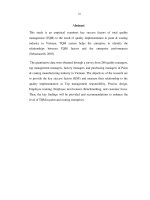Interactivity, presence, and purchase intention an empirical study in virtual collaborative shopping
Bạn đang xem bản rút gọn của tài liệu. Xem và tải ngay bản đầy đủ của tài liệu tại đây (1.72 MB, 93 trang )
INTERACTIVITY, PRESENCE, AND PURCHASE
INTENTION: AN EMPIRICAL STUDY IN VIRTUAL
COLLABORATIVE SHOPPING
LIU XIN
NATIONAL UNIVERSITY OF SINGAPORE
2005
INTERACTIVITY, PRESENCE, AND PURCHASE
INTENTION: AN EMPIRICAL STUDY IN VIRTUAL
COLLABORATIVE SHOPPING
LIU XIN
(M.Sc, National University of Singapore)
A THESIS SUBMITTED
FOR THE DEGREE OF MASTER OF SCIENCE
DEPARTMENT OF INFORMATION SYSTEMS
NATIONAL UNIVERSITY OF SINGAPORE
2005
i
Acknowledgements
I would like to express my gratitude to my supervisor, Dr. Teo Hock Hai, for his
support, help, and guidance throughout the conduct of this research. Without his help
and directing, I could hardly complete this work.
I also need to acknowledge Dr. Bock Gee-Woo and Dr. Jiang Zhenhui for the time
and efforts they devoted in attending my presentation and the constructive comments
they made on my works.
I am also grateful to my friends Tan Chuan Hoo and Xu Heng for their
encouragement and generous help. I benefited a lot from discussions with them. I owe
many thanks to them.
Last, but not least, I would like to thank my family for their love, encouragement, and
constant support throughout my study. I dedicate this thesis to them.
ii
Contents
Page
Title
i
Acknowledgements
ii
Contents
iii
Figures
v
Tables
vi
Summary
vii
Chapter 1 Introduction............................................................................................... 1
1.1 Background ......................................................................................................... 1
1.1.1 Virtual Collaborative Shopping ................................................................... 1
1.1.2 Presence ....................................................................................................... 2
1.1.3 Interactivity .................................................................................................. 3
1.2 Motivations of Research ..................................................................................... 5
1.3 Research Questions............................................................................................. 6
1.4 Research Objective and Scope............................................................................ 7
1.5 Thesis Organization and Structure...................................................................... 7
Chapter 2 Literature Review ..................................................................................... 9
2.1 Virtual Collaborative Shopping .......................................................................... 9
2.1.1 Meaning of Collaboration ............................................................................ 9
2.1.2 Collaborative Virtual Environment............................................................ 10
2.2 Presence ............................................................................................................ 12
2.2.1 Presence Theories ...................................................................................... 12
2.2.2 Interactivity ................................................................................................ 16
Chapter 3 Research Model and Hypotheses........................................................... 18
3.1 Research Model ................................................................................................ 18
3.1.1 Independent Variables ............................................................................... 19
3.1.2 Dependent Variables.................................................................................. 20
3.1.3 Controlled Variables .................................................................................. 22
3.2 Research Hypotheses ........................................................................................ 23
3.2.1 Interactivity ................................................................................................ 23
3.2.2 Presence ..................................................................................................... 25
3.2.3 Purchase Intention...................................................................................... 26
iii
Chapter 4 Research Methodology ........................................................................... 27
4.1 Experimental Design......................................................................................... 27
4.2 Independent Variables ...................................................................................... 28
4.2.1 Object Interactivity .................................................................................... 28
4.2.2 Person Interactivity .................................................................................... 28
4.3 Dependent Variables......................................................................................... 29
4.3.1 Telepresence .............................................................................................. 30
4.3.2 Social Presence .......................................................................................... 30
4.3.3 Satisfaction................................................................................................. 30
4.3.4 Purchase Intention...................................................................................... 31
4.4 Controlled Variables ......................................................................................... 31
4.5 Experimental Details......................................................................................... 32
4.5.1 Subjects ...................................................................................................... 32
4.5.2 Design of Experiment Website .................................................................. 32
4.5.3 Experimental Procedures ........................................................................... 33
Chapter 5 Data Analyses .......................................................................................... 34
5.1 Manipulation Check and Control Check........................................................... 34
5.1.1 Manipulation Check................................................................................... 34
5.1.2 Control Check ............................................................................................ 35
5.2 Model Testing ................................................................................................... 36
5.2.1 Measurement Model .................................................................................. 38
5.2.2 Structural Model ........................................................................................ 40
Chapter 6 Discussion and Implications................................................................... 42
6.1 Discussion of Results........................................................................................ 42
6.2 Implications for Practice and Research............................................................. 44
Chapter 7 Conclusion ............................................................................................... 46
7.1 Contributions..................................................................................................... 46
7.2 Limitations ........................................................................................................ 46
7.3 Concluding Remarks......................................................................................... 48
REFERENCES.......................................................................................................... 49
APPENDICES ........................................................................................................... 56
Appendix 1: Measurements .................................................................................... 56
Appendix 2: Experiment Website Screen Shots ..................................................... 59
Appendix 3: Questionnaire ..................................................................................... 79
iv
List of Figures
Figure 3.1 Research Model....................................................................................... 19
Figure 5.1 Structural Model..................................................................................... 40
v
List of Tables
Table 3.1 Controlled Variables................................................................................ 23
Table 4.1 Experimental Design................................................................................ 27
Table 5.1 Manipulation Check ................................................................................ 35
Table 5.2 Control Check........................................................................................... 36
Table 5.3 Analysis of Variance ................................................................................ 37
Table 5.4 Psychometric Properties of the Measurement Model........................... 39
Table 5.5 Discriminant Validity of Constructs....................................................... 40
Table 5.6 Results of Hypothesis Testing ................................................................. 41
vi
Summary
Shopping is a social activity that people enjoy doing along with friends and close
ones. We specify the concept of virtual collaborative shopping in this study as online
shopping activity performed by two or more people together. This study is one of the
first attempts to study factors that influence consumer attitude and behavior in the
context of virtual collaborative shopping.
Presence is recognized as an essential factor that distinguishes collaborative virtual
environment technology. The influence of presence on user’s attitudes and behavior is
widely reported in the literature. This research studied the effects of technological
characteristics (i.e. object interactivity and person interactivity) on the formation of
presence, and the impact of presence on consumer satisfaction and purchase intention.
This study adopted a multi-dimensional conceptualization of presence, highlighting
the importance of the conceptual distinction between telepresence and social presence
and the necessity of the simultaneous consideration of these two types of presence.
An experiment involving 200 subjects was conducted to test the research model. The
study was a 2 (object interactivity) × 2 (person interactivity) factorial design. Results
show that object interactivity is a significant predictor of telepresence. Person
interactivity has positive effects on both telepresence and social presence. Both
telepresence and social presence positively influence satisfaction. Satisfaction
significantly affects purchase intention. Results suggest that person interactivity has a
vii
strong impact on social presence. Further analysis reveals that social presence plays a
more critical role than telepresence in influencing consumer satisfaction.
This study takes into account of the social aspects of human interaction with
technology. It enlightens the marketers with practical insights. We believe that
research on collaborative shopping deserves more attention. This study lays useful
foundation for future researchers.
viii
Chapter 1 Introduction
1.1 Background
1.1.1 Virtual Collaborative Shopping
The popularity of Internet has brought great convenience to information and services
users. But so far, the use of information and services online has been a solitary
experience (Puglia et al. 2000). Most of the existing e-commerce websites are
designed to support isolated shopping. Consumers navigate around pages and perform
e-commerce activities basically alone, experiencing everything on their own.
However, research in consumer behavior and social psychology argues that much of
the consumer behavior is not solely an individual transaction, but rather is highly
social and collaborative (Underhill 1999; Miller 1998). There is evidence that people
enjoy shopping with friends and relatives in a social and collaborative environment
(Marathe 1999; Warms et al. 2000; O’Hara and Perry 2003). For example, Underhill
(1999) found in his study that women shopping with a female companion shopped
longer than they shopped alone. He further pointed out that the amount of time
shoppers spend in a store is the single most significant predictor of how much they
buy. Research in consumer behavior also indicates that those who shop in groups may
purchase more and spend more money than when shopping alone (Sommer et al
1992). Collaborative shopping provides consumer with moral support, taste tips,
companionship, expertise etc. A consumer may defer purchase impulse when there is
no one to seek reassurance and advice from (Sommer et al. 1992).
1
In e-commerce context, research in consumer attitude and behavior also advocates
technologies and services that facilitate social interaction and enhance the social
experience of online shopping activities (O’Hara and Perra 2003). Considering the
consequential impact of supporting social interaction, e-commerce marketers and
system designers are beginning to address the social needs of online consumers by
adding more support for collaboration. We specify the concept of collaborative
shopping in this study as shopping activity performed by two or more people together.
For instance, the Land’s End site (landsend.com) once provided a co-browsing
environment within which friends can shop together synchronously. Several
prototype frameworks for collaborative shopping were developed, such as
MultECommerce by Puglia et al. (2000), vCOM by Shen et al. (2002), etc.
1.1.2 Presence
The advancement of information technology has made it possible for online
consumers to meet and collaborate in socially rich virtual environments. However,
concerns about the degree of presence in those collaborative virtual environments
have been raised. The general goal of all virtual environments is to create a sense of
presence (Tromp 1995; Slater and Wilbur 1997). The specific goal of all collaborative
virtual environments is to facilitate collaboration among participants. Research in
collaborative virtual environment (CVE) recognizes the perceived sense of presence
an essential factor that distinguishes CVE technology (Psotka 1995). Experiencing
one’s own presence as well as the presence of other participants is an important
feature of CVE (Steed and Tromp 1998). The obvious benefit of presence in
2
collaborative virtual environments is that presence leads to greater degree of
engagement, excitement and satisfaction (Bricken and Byrne 1993).
In the literature, presence was recognized as consisting of two different yet
complementary dimensions: telepresence and social presence (Biocca 1997; Biocca et
al. 2003; Heeter 1992; Buxton 1993). Telepresence characterizes the illusion of being
physically present in the mediated environment (Lombard and Ditton 1997; Sheridan
1992, 1996; Steuer 1992; Zeltzer 1992; Slater and Usoh 1993; Witmer and Singer
1994; Schloerb 1995; Witmer and Singer 1998). Social presence refers to the degree
to which a medium allows a user to establish personal connection with other users
(Short et al. 1976). Most of the immersive virtual shops facilitate the sense of
telepresence, but target individual shopping rather than collaborative shopping. There
is evidence that applications in shared virtual environments are based on providing a
mix of both components (i.e. telepresence and social presence) (Lessiter et al. 2001;
Ijsselsteijn et al. 2001). Experiencing the presence of other participants is closely
allied with experiencing one’s own presence in collaborative virtual environments
(Holderness 1998).
1.1.3 Interactivity
Although to a certain extent, telepresence and social presence can be meaningfully
distinguished, they are closely correlated. Interactivity is an important common
determinant telepresence and social presence share (Ijsselsteijn and Riva 2003).
3
In prior research, interactivity has received considerable attention from multiple
disciplines. Hoffman and Novak (1996a) identify two levels of interactivity: machine
interactivity and person interactivity. Machine interactivity refers to “the extent to
which users can participate in modifying the form and content of a mediated
environment in real time”. Person interactivity refers to interactivity between people
that occurs “through a medium”. In the latter view of interactivity, media are
“important only as a conduit, as a means of connecting sender and receiver” (Steuer
1992). The implicit assumption is that the characteristics of the medium allow only
limited aspects of content to be communicated (Hoffman and Novak 1996a).
In virtual reality context, object interactivity, the extent to which users can directly
manipulate objects in a virtual world (Schlosser 2003), is gaining more and more
attention from both academia and practice. Object interactivity is an important form
of the user interaction with the machine (Schlosser 2003). With direct manipulation,
there is a continuous change in graphics as a result of user behaviors (Shneiderman
1987). Many extant e-commerce websites allow consumers to manipulate products
online, aiming at providing online consumers virtual product experience that mimics
the direct one. For instance, consumers visiting Kodak’s website are provided with a
product demonstration. Consumers can press the buttons on the camera with their
pointer to try the camera and view it from different angles.
Individual immersive virtual environments facilitate interaction with virtual objects,
while collaborative virtual environments allow users to interact with both objects and
4
collaborators. Interaction in a collaborative virtual environment is based on the
interplay of the two components of object interactivity and personal interactivity. The
process of interaction cannot be understood fully from any of the components alone.
1.2 Motivations of Research
Virtual collaborative shopping has drawn certain attention from e-commerce
practitioners, but academic research has been a recent phenomenon. The motivations
of this study are as follows:
First, presence is proposed to be an essential factor distinguishing collaborative
virtual environment (CVE) technology (Psotka 1995). It has long been recognized as
an important factor in explaining user behavior and performance in virtual
environments (Khalifa and Shen 2004). However, prior research in virtual
collaborative shopping is largely technology-driven and there is little knowledge
about how website should be designed to facilitate the sense of presence. The
influence of presence on consumer attitude and behavior remains unprobed.
Second, telepresence and social presence are distinct feelings that can be perceived
during the same web-base application (Khalifa and Shen 2004). Most of the extant
research investigated the role of presence either without simultaneous consideration
of telepresence and social presence, or without conceptual distinction between them.
Our research attempts to address this void. Given that telepresence and social
presence can be perceived simultaneously and may affect consumer’s attitude and
5
behavior differently in our research context, we highlight the importance of the
conceptual distinction between telepresence and social presence and the necessity of
the simultaneous consideration of these two types of presence.
Finally, interactivity is identified as a significant determinant of presence. As it is a
multidimensional construct (Ha and James 1998) consisting of object interactivity and
person interactivity in our research context, it is important to distinguish the two
levels of interactivity and investigate their effects on telepresence and social presence
respectively. Prior research examining the impact of interactivity on presence tends to
opt for a holistic perspective.
1.3 Research Questions
In this study, virtual collaborative shopping is defined as online shopping activity
performed by two or more people together. This study is one of first few that attempts
to investigate the relationship between important systems design features and
perceived presence, as well as the impact of presence on consumer attitude and
behavior. In particular, this study seeks to answer the following research questions:
1. What are the impacts of interactivity (i.e. object interactivity, personal
interactivity) on consumer’s perceived sense of presence (i.e. telepresence,
social presence)?
2. What are the impacts of presence (i.e. telepresence, social presence) on
consumer attitude and behavior?
6
1.4 Research Objective and Scope
This research is an exploratory one in virtual collaborative shopping field. Despite
striving to answer the research questions listed above, it seeks to provide guidelines
for website designers, and to advocate future research directions. We chose to focus
our current study on virtual collaborative shopping due to its massive potential as
mentioned earlier. We will not attempt to generalize our findings to other business-toconsumer e-commerce settings.
1.5 Thesis Organization and Structure
This thesis is organized into 7 chapters. Chapter 2 reviews the relevant literature of
virtual collaborative shopping and presence. It examines factors that are essential to
virtual collaborative shopping. Presence and interactivity that are related to this
research context are discussed.
Chapter 3 outlines the theoretical foundations for the study. It presents the research
model depicting the independent, dependent and controlled variables. The hypotheses
are developed based on the support of relevant literature.
Chapter 4 explains the research methodology. It presents the experimental design by
explaining how each of the independent variables was manipulated. It explains the
experimental details such as subject, website design, and experiment procedures. The
design and adoption of the scale to measure the dependent variables and other
variables are reported.
7
Chapter 5 reports the results of the statistical analyses performed on the experimental
data. It illustrates the tests conducted to ensure that the manipulation of independent
variables and regulation of controlled variables were successful. It presents the
outcomes of the statistical analyses carried out to assess the research hypotheses.
Chapter 6 interprets the statistical analyses findings and evaluates the research model
and hypotheses. It discusses the significance of the results and examines implications
for practice and research highlighted by these findings.
Chapter 7 concludes this thesis. Contributions and limitations of this study are
discussed.
8
Chapter 2 Literature Review
This chapter gives a review of research relevant to virtual collaborative shopping and
presence literature. The review is important in our understanding of the factors that
are essential to virtual collaborative shopping. This literature is drawn from several
disciplines including marketing, sociology, communications and information systems.
2.1 Virtual Collaborative Shopping
Virtual collaborative shopping can be defined as online shopping activities conducted
by two or more people together. As the technology improves, consumers are
demanding for more collaboration online. In the recent past, technologies that support
virtual collaboration are widely used in virtual conferencing, shared virtual learning
environment, network interactive 3-D games, and virtual shopping malls.
Collaborative virtual environment offers software systems in which multiple users
who are physically separated interact with each other synchronously. The following
session gives a brief review of research relevant to virtual collaborative shopping.
2.1.1 Meaning of Collaboration
In simplest terms, collaboration refers to working together to accomplish a common
goal. Technology advancement in IT and communication has widened the scope of
collaboration. Today, collaboration includes shared virtual environment that allows
geographically separated users to communicate and work jointly. Applications of
collaborative virtual environments are widely used in the areas of education, virtual
9
shopping, architecture, visualization, tele-medicine, psychotherapy, games, flight
simulators, and military etc. The number of participants in a virtual environment and
the extent to which they interact defines whether the application is collaborative
(Kaber et al. 2002).
Steed and Tromp (1998) propose that most central to collaboration is the support for
mutual awareness. This involves awareness of the presence of other participants, but
also recognition of current activity of the other participants. Also central to
collaboration is support for communication between participants. Doing something
together implies rather synchronous communication (Dillenbourg 1999).
Roschelle and Teasley (1995) define collaboration as “…a coordinated, synchronous
activity that is the result of a continued attempt to construct and maintain a shared
conception of a problem”. This definition implies that a collaborative virtual
environment should facilitate shared understanding. Common ground is the shared
understanding that arises through a shared context and effective communication
(Clark and Brennan 1991; Preece 2000). A collaborative virtual environment should
enable the participants to build the common grounds necessary for them to perform
well together.
2.1.2 Collaborative Virtual Environment
The general goal collaborative virtual environments share in common is to create a
place for people to interact. Online users need to feel present in this space in order to
10
make sense of this virtual environment (Tromp 1997). For this reason, collaborative
virtual environment usually aims at creating an immersive experience for online users
(O’Hara and Perry 2003). Presence in the form of telepresence has received
considerable attention in virtual reality research (Tromp 1995).
The other dimension that is presumed to be important for efficient and effective
collaborative behavior is the feeling of social presence (Romano et al. 1998; Lockner
and Winroth 1999). In order to facilitate collaboration, collaborative virtual
environments should make the participants aware of other participants, as well as the
relationships between them, i.e. provide a sense of social presence. Social presence in
collaborative virtual environments is recognized as important a goal as conventional
telepresence (Brown and Bell 2004). In particular, a collaborative virtual environment
offers support for social interactions, and consequently induces the sense of social
presence felt in the online environment.
Experiencing one’s own presence as well as the presence of other participants plays a
critical important role in collaborative virtual environments (Ijsselsteijn and Riva
2003). The extent to which the participants feel present in a collaborative virtual
environment depends on the same factors that determine presence in individual
immersive virtual environments. However, a strong sense of social presence is also
believed to overcome deficiencies in the virtual environment in terms of the technical
limitations or lack of sensory immersion (Lombard and Ditton 1997). Being a multiuser virtual environment designed to support collaborative activities, a collaborative
11
virtual environment provides communication tools to facilitate collaborative activities
(Churchill and Snowdon 1998).
It is proposed that the sense of presence in a
collaborative virtual environment will be increased by fostering interactions with the
environment in which alterations of the environment caused by actions of one
participant are clearly perceived by the other participants (Durlach and Slater 2000).
2.2 Presence
This section gives a brief review of presence literature. The theoretical and
technological aspects of presence that contribute to our research are reviewed.
2.2.1 Presence Theories
Presence research has received a lot of attention in the recent past. The following
section examines the past research and draws upon the presence theories to
understand the concept of presence, telepresence and social presence.
The research on presence emerges from multiple disciplines, such as communication,
virtual reality, computer science, and psychology. However, the lack of a unified
conceptualization makes it difficult to communicate among researchers from different
fields (Lee 2004). In this study, presence is recognized as a multidimensional concept
(Lombard and Ditton 1997; Lee 2004), which is broadly defined as “the perceptual
illusion of non-mediation” (Lombard and Ditton 1997). Non-mediated experience
means that the experience is experienced without any technology in the way.
12
Lombard and Ditton (1997) identify six interrelated but distinct conceptualizations of
presence, exhibiting the multidimensionality of presence. Ijsselsteijn et al. (2000)
later groupe them into two broad categories: physical presence and social presence.
Physical presence refers to the “sense of being there”; while social presence refers to
the sense of being together with other people or social entities (Biocca et al. 2003).
According to Khalifa and Shen (2004), for mediated environments, such as TV or
computer-based environment, telepresence is the more specific term that is used for
physical presence. In prior literature, presence was recognized as consisting of two
different yet complementary dimensions: telepresence and social presence (Biocca
1997; Biocca et al. 2003; Heeter 1992; Buxton 1993). Telepresence characterizes the
illusion of being physically present in the mediated environment (Lombard and
Ditton 1997; Sheridan 1992, 1996; Steuer 1992; Zeltzer 1992; Slater and Usoh 1993;
Witmer and Singer 1994, 1998; Schloerb 1995). Social presence refers to the degree
to which a medium allows a user to establish personal connection with other users
(Short et al. 1976).
2.2.1.1 Telepresence
The concept of telepresence has long been around since certain areas of the industry
started to design remote control systems and industrial robots. The term was coined
by Minsky in 1980, and refers to an operator’s sense of being somehow physically
present at a remote location during the telemanipulation of real objects. In the
literature, many older definitions are based on such teleoperation (human
13
manipulation of elements of a remote environment) context (Sheridan 1992; Heeter
1992; Held and Durlach 1992). However, the roots of telepresence are not so
constrictive. Despite early applications in teleoperation in industrial field,
telepresence is now widely utilized in a number of fields like e-marketing, telelearning, tele-conferencing etc. With the increasing and far-ranging applications in
various fields, the boundary of telepresence has extended. Telepresence is defined as
a mental state in which a user feels physically present within the virtual environment
(Draper et al. 1998; Witmer and Singer 1998; Kim and Biocca 1997; Slater and
Wilbur 1997; Steuer 1992).
In e-commerce context, the role of telepresence on consumer attitude and behavior
has begun to be investigated. Hoffman and Novak (1996a) recognize telepresence an
important antecedent of flow experience, which significantly affects online
consumer’s cognitive responses and exploratory behavior. Telepresence is also
posited to provide the medium that bridges the gap between information
representation and direct product experience, consequently resulting in positive
impact on persuasion and consumer learning (Jeandrain 2001a; Klein 2002; Li et al.
2001, 2002, 2003). Through a series of studies on online advertising, Li et al. (2001,
2002, 2003) argue that online advertising which offers consumer immersive virtual
product experience enhances consumer learning, and positively affects consumer’s
product knowledge, brand attitude and purchase intention.
14
2.2.1.2 Social Presence
Social presence refers to the degree to which a medium allows a user to establish
personal connection with other users (Short et al. 1976). Social presence theory posits
that social presence is inherent in a communication medium, and thus a certain
medium has higher social presence than others. With the increasing ability to
facilitate understanding, connection, involvement and interaction among online users,
or between online users and computer agents, e-commerce websites are conveying
increasing degree of social presence.
Social presence is dependent not only on the words involved in the communication
but also on the full range of verbal and nonverbal cues, and the communication
context (Rice 1992). A higher level of presence in a medium confers the attributes of
being more sociable, more personal, more sensitive, and warmer. Short et al. (1976)
emphasize the need for social presence, i.e. the quality of the communication medium
that is required to understand person-to-person communications. Social presence has
been included in the research on web-based communications as a central construct in
explaining important determinants of user attitude and behavior.
A major factor of failure e-commerce websites is ignoring important requirements
that result from human, cultural and social factors (Andreou et al. 2002). Social
presence has been argued to facilitate persuasion and sales (Fogg and Tseng 1999;
Moon 1998). Recent work by Biocca et al. (2003) argues that the level of satisfaction
in collaborative virtual environments is based largely on the quality of social presence.
15
2.2.2 Interactivity
Presence is a subjective perception of the virtual environment, and depends on the
technological characteristics of the media. The determinants of presence have long
been investigated in the literature. Most of the past studies focus on the technological
features of the media (Ijsselsteijn et al. 2000). Steuer (1992) conceptualizes the
technological features into two constructs, i.e. interactivity and vividness. Lombard
and Ditton (1997) provide a comprehensive review of technological features
influencing presence. Most prior studies recognize interactivity as an important
determinant of presence.
However, interactivity is a complex and multidimensional concept (Lombard and
Synder-Duch 2001). In the literature, two primary approaches were employed to
conceptualize interactivity. From the technology perspective, interactivity is
recognized as the characteristics of a medium (Steuer 1992), and is defined as “the
extent to which users can participate in modifying the form and content of a mediated
environment in real time.” From the interpersonal communication perspective,
interactivity is defined as “the extent to which messages in a sequence relate to each
other, and especially the extent to which later messages recount the relatedness of
earlier messages” (Rafaeli and Sudweeks 1997). Both of the two perspectives shed
light on an important aspect of interactivity. Hoffman and Novak (1996a) further
identify two levels of interactivity: machine interactivity and person interactivity.
Machine interactivity refers to the extent to which users can participate in modifying
16




![chung - 2004 - selective mandatory auditor rotation and audit quality - an empirical investigation of auditor designation policy in korea [mar]](https://media.store123doc.com/images/document/2015_01/06/medium_bpj1420548143.jpg)




